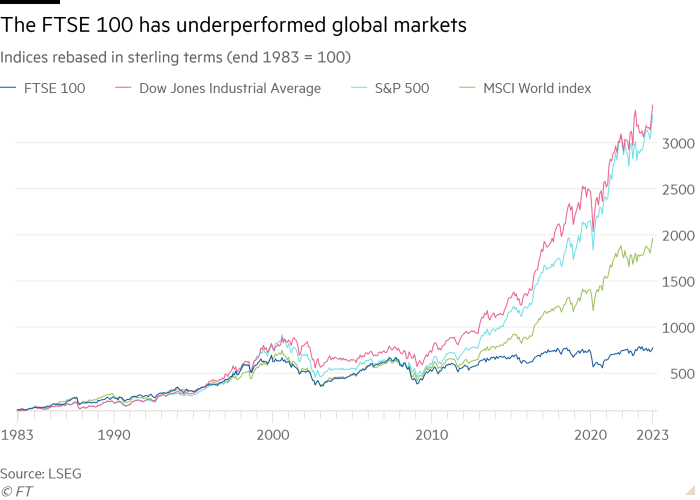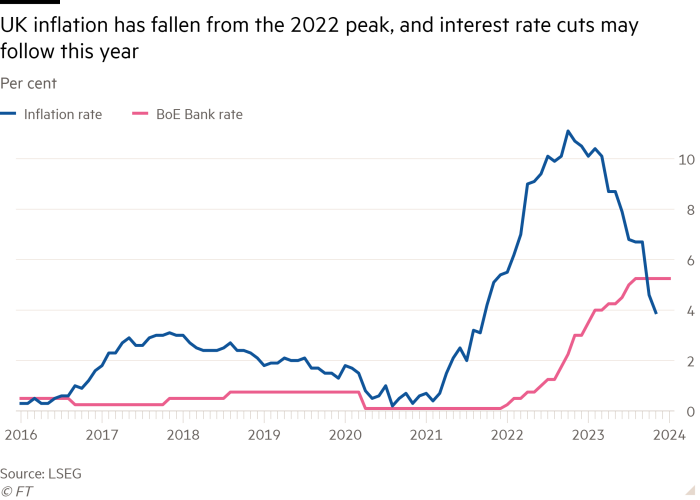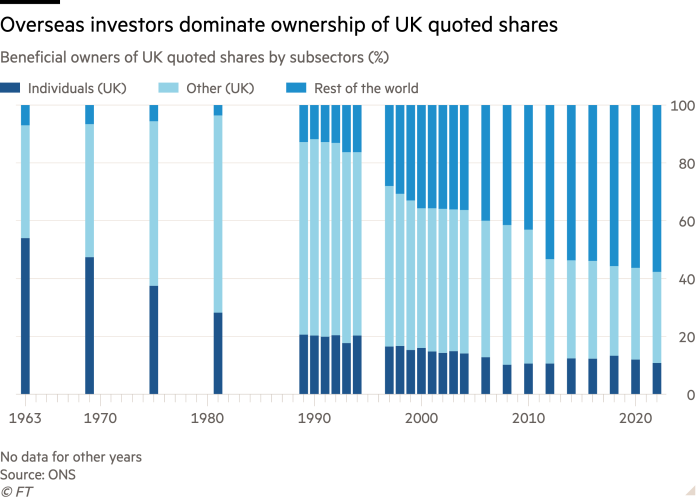What can investors expect from 2024?

Simply sign up to the Investments myFT Digest -- delivered directly to your inbox.
Forecasting the economic and financial outlook for the coming year is always difficult. In 2020, the surprise came in the form of a global pandemic; in 2022, it was Russia’s invasion of Ukraine. For 2024, the known unknowns come in two categories: economics and politics.
The likely good news comes in the form of falling inflation and the widespread expectation that the Federal Reserve, and other central banks, will start to cut interest rates during the year. Anticipation of this policy shift sparked a strong rally in US equities in November and December, making 2023 the best year for global equities since 2019. The potential downside, however, is that monetary policy has a lagged effect. Some economists worry that the monetary tightening in 2022 and 2023 will have an adverse economic impact in 2024.
So the big issue for 2024 is whether the central banks have got it right. Have they done enough to slow inflation without sending the economy into recession? Alternatively, are inflationary impulses so ingrained that central banks may have to tighten once more over the coming year?
For UK investors and savers, the answers to these questions will be vital in determining the best way of allocating their portfolios and the returns they are likely to make. Should they opt for equities as the best long-term bet or take advantage of the better returns now available on savings accounts?

Cross-currents ahead
A broader concern is whether China is starting to lose its role as the driving force of the world economy; it provided almost half of global GDP growth over the past 10 years.
Dhaval Joshi of BCA Research argues that Chinese residential property is massively overvalued. The Chinese government cannot risk letting house prices fall, given the potential impact on the wealth of ordinary citizens. Instead he says that the Chinese will engineer “a reduction in housing development and construction activity to equilibrate supply with collapsing demand.”
He says: “This has huge implications for the world economy because China’s construction and infrastructure boom has been the world’s main growth engine, and that engine is about to die.”
Such concerns explain why economists are generally quite cautious about the outlook for 2024. Citibank, for example, expects global GDP growth to be just 1.9 per cent and Deutsche Bank 2.4 per cent. Such figures are very weak by the standards of the past three decades. Meanwhile, expectations for US growth are in the 1-2 per cent range — respectable, but hardly dazzling. In the UK, the Office for Budget Responsibility forecasts a sluggish 0.7 per cent GDP rise for the year.
Forecasters are often wrong, of course. US growth in 2023 was better than expected. The strength of the labour market has been a constant surprise in many parts of the world. Despite slow growth, UK unemployment is still just 4.2 per cent, while in the US it is even lower at 3.7 per cent.
However, even if growth turns out to be better than expected, the US equity market has priced in quite a lot of good news. The price/earnings ratio on the S&P 500 is more than 25, based on the last year’s earnings; on the longer-term cyclically-adjusted ratio, it is 31.
That valuation strength owes much to the technology sector, which remains the darling of investors.
The top 10 stocks in the S&P 500 make up about one-third of the index, the highest proportion since the dotcom bubble of 2000. Of that top 10, the largest six (Apple, Microsoft, Alphabet, Amazon, Nvidia and Meta) are in the tech sector, while the seventh biggest, Tesla, the car company, owes much to its technological expertise.
The big tech companies have attracted ire from regulators and politicians, based on their monopolistic positions, intrusions into privacy and their control (or failure to control) free speech on their networks. If regulators or political leaders take significant action, tech shares could be vulnerable to a derating. Even without regulatory action, tech shares could lose momentum; Apple’s sales have fallen for four consecutive quarters, for example.
There is also something of a soft underbelly about the US corporate sector. Torsten Slok of Apollo Global Management points out that 40 per cent of companies in the Russell 2000 index have negative earnings. That is around the level seen during the 2007-08 financial crisis. In addition, both Chapter 11 bankruptcies and default rates on corporate bonds are trending higher, doubtless a response to rising interest rates.

A year for equities?
Furthermore, there are worrying signs at the global level. The profits for companies in the MSCI World index were flat in 2023, according to Ed Yardeni of Yardeni Research. Revenues were also sluggish, showing just a 1 per cent increase. Investors are more hopeful about 2024, with analysts pencilling in a 10 per cent earnings increase at the global level. However, analysts usually start the year in an optimistic mood, revising down forecasts only when faced with grim reality.
Despite these concerns, it is certainly possible that equities will have a good 2024; stock markets are often described as climbing a “wall of worry”. Falling interest rates are generally good for shares, as long as they are not accompanied by a very deep recession. The oil price is well down on its levels in 2022, when investors were spooked by Russia’s invasion of Ukraine. Lower oil prices should bring some relief to both consumers and businesses. If, as many suspect, China’s growth rate slows, commodity prices in general will come under pressure and that should help to bring inflation down further.
Falling commodity prices and a sluggish Chinese economy are not a great combination for emerging markets. But the prospect of lower US interest rates in 2024 should allow central banks in developing countries to cut interest rates. In short, as with other equity markets, the outlook is distinctly mixed.
On the surface, the prospects for the government bond market in the US and UK seem more clear than for the equity market. If inflation has peaked, and central banks are able to cut interest rates, then government bonds should do reasonably well. Some of the good news is already reflected in the price; the 10-year US Treasury bond yield has dropped from 5 per cent in October to around 3.9 per cent today.
If investors believe the Fed can maintain inflation at around 2 per cent over the next decade, that represents a reasonably positive real return. In the UK, 10-year gilt yields are about 3.7 per cent. Again, if the Bank of England meets its 2 per cent inflation target, gilts should generate a positive real return.

Election season
Sometimes, of course, the market can be derailed by events (like the pandemic and Russia’s invasion of Ukraine) that do not have their underlying drivers in economics. In 2024, these events could stem from politics. The primary concern is elections in the UK and the US.
At the moment, the Labour party seems likely to win a majority in a UK election that is likely to occur in May or October. As Labour is now led by the moderate Sir Keir Starmer, following the more leftwing Jeremy Corbyn, a change of government is unlikely to startle investors. But if a hung Parliament were to seem likely, in which Labour was dependent on support from the Scottish National party, uncertainty would increase.
In the US, November’s election seems likely to be a repeat of the 2020 contest between Joe Biden and Donald Trump, candidates with a combined age on election day of 159. The markets did pretty well under the first Trump administration so it might seem as if investors have little to worry about. But the circumstances of the 2020 election should be very concerning to all those who worry about the long-term stability of the US. Martin Wolf, the FT’s chief economics commentator, wrote that a Trump win would mean the US was “no longer committed to democratic norms”.
If Trump loses, he is likely, once again, to refuse to accept the result, leading to unrest by his supporters. And there is also a chance that he might try to use the tactics he suggested in 2020 in an effort to win — for example, using his supporters in state governments to alter the slate of electors in contravention of the recorded vote. That might lead to widespread protest by opponents of his rule and prolonged legal action that would keep the outcome in doubt. So there could be plenty of turmoil at the end of 2024.
More broadly, geopolitical risks that might emerge this year include further aggression from Vladimir Putin’s Russia. This might occur if he is emboldened by success in Ukraine (due to a loss of support for the invaded nation from the US) or if he is frustrated by the failure of his invasion.
There is the obvious risk that Israel’s attempt to eliminate Hamas from Gaza will lead to a wider Middle East conflict. And there is also a danger that China might decide to strike against Taiwan, particularly if it feels that the US is weakened by its internal divisions.
There are always political worries, of course, and in most years, the world manages to muddle through. If, as expected, the Fed cuts interest rates several times next year, consumers should feel more prosperous and the turbulence of a Trump victory can be avoided. All this should support both stock and bond markets. But it would be unwise to be too confident. The past few years have shown that negative surprises can come in many forms and, after the recent rally, the US stock market is priced on the assumption that good news will persist.
Forty years of the FTSE 100

This year marks the 40th anniversary of the FTSE 100 index, which was created in 1984 to replace the rather old-fashioned FT-30 as the main benchmark of the UK stock market. The index’s history can be divided into halves. In the first, between the start of 1984 and the end of 1999, the benchmark had lots of momentum, advancing from its original level of 1,000 to almost 7,000 at the end of the last millennium. Since then, it has been very slow progress. The 7,000 mark was not properly breached until 2015 and while the 8,000 mark was passed early in 2023, the index is still stuck in the 7,000-8,000 range.
To put that performance in perspective, the Dow Jones Industrial Average was only just above 1,000 at the start of 1984 but trades in the mid-30,000s today. The broader S&P 500 was 164 at the start of 1984 and is in the mid-4,000s now. Instead of mimicking the entrepreneurial US, the UK market has behaved rather more like corporatist France; Paris’s CAC 40 index started in 1987 with a level of 1,000 and is in the mid-7000s today.
Part of the reason for Footsie’s sluggish performance relative to the Dow or the S&P 500 is the lack of a thriving technology sector. In 1984, when the internet was a twinkle in the eye of Tim Berners-Lee, the UK’s leading index had two technology stocks. Forty years later, it still does. It was a sign of the times when Arm, the chip designer, decided to list in the US rather than the UK when it returned to the market in September. In some ways, the UK market is frozen in aspic; almost a quarter of the index in 1984 was composed of financials and real estate; they make up the same proportion of the index today.
However, at the individual stock level, there has been plenty of change. Just 26 of the original 100 constituents have survived, although not all in the same form. The best performer over the 40 years is RELX, an analytics and information company. Back in 1984, when it was Reed International, a book and magazine publisher, it would probably not have been many people’s pick as the stock that would rise more than sixtyfold over the next 40 years. But a merger with Elsevier, a Dutch scientific publisher, in 1993 transformed the group’s prospects.
The other four of the top five performers over the past 40 years are all in the consumer staples sector, which is not often tipped by pundits selecting the next hot stock. But Unilever, Associated British Foods and Reckitt Benckiser all sell goods that consumers demand, year after year, while British American Tobacco produces goods that some people simply cannot do without.
That said, selling to consumers has not been a sure-fire route to success; two of the five worst-performing stocks have been J Sainsbury and Marks and Spencer, which have each seen their positions eroded by competition. But the two worst performers of all are Lloyds Bank and NatWest. The latter has a complicated history. The original NatWest was taken over in 2000 by the Royal Bank of Scotland, as part of an acquisition spree that turned RBS into the world’s biggest bank. After RBS collapsed in the 2008 financial crisis, it reverted to the NatWest name.
If the FTSE 100 index is to do better in the next 40 years than the past four decades, it is going to need to depend less on financials and more on some dynamic sectors.
Comments